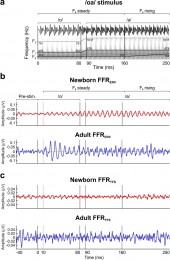The paper entitled Neural encoding of voice pitch and formant structure at birth as revealed by frequency-following responses, by, Arenillas-Alcón, S., Costa-Faidella, J., Ribas-Prats, T., Gómez-Roig, M.D., and Escera, C. has been published in the journal Scientific Reports.
This paper is the second published outcome of the scientific collaboration between the Brainlab and the Obstetrics and Gynecology Department of the Sant Joan de Déu Hospital (HSJD) in Barcelona, led by Dr. M.Dolores Gómez-Roig, in the context of the Catalan CERCA Center Institut de Recerca Sant Joan de Déu (IRSJD). The main goal of this collaboration is to established the Frequency-Following Response (FFR) as a neonatal biomarker for neurocognitive development, in particular regarding language acquisition. The focus of this collaborative research program is twofold: 1) to characterize the normal development of the FFR along the first year of life vis-à-vis maturational changes in the auditory hierarchy as informed by structural (volumetric and diffusion) MRI), and 2) to reveal through FFR recordings the neural consequences at birth of environmental factors challenging fetal development, such as those leading to fetal growth restriction, alcohol intake during pregnancy or being born large for gestational age.
In this study, Arenillas-Alcón have developed a new FFR-eliciting stimulus that is able to reveal the neural encoding of both the fundamental frequency (F0) and temporal fine structure (formants) of speech sounds, through the proper analysis of averaged and subtracted responses, respectively, to stimuli delivered at alternating polarities. The main outcome of the study is that while encoding of the F0 is already adult-like at birth, encoding of the temporal fine structure is still to mature for the higher harmonics.

The full abstract reads as follows:
Detailed neural encoding of voice pitch and formant structure plays a crucial role in speech perception, and is of key importance for an appropriate acquisition of the phonetic repertoire in infants since birth. However, the extent to what newborns are capable of extracting pitch and formant structure information from the temporal envelope and the temporal fine structure of speech sounds, respectively, remains unclear. Here, we recorded the frequency-following response (FFR) elicited by a novel two-vowel, rising-pitch-ending stimulus to simultaneously characterize voice pitch and formant structure encoding accuracy in a sample of neonates and adults. Data revealed that newborns tracked changes in voice pitch reliably and no differently than adults, but exhibited weaker signatures of formant structure encoding, particularly at higher formant frequency ranges. Thus, our results indicate a well-developed encoding of voice pitch at birth, while formant structure representation is maturing in a frequency-dependent manner. Furthermore, we demonstrate the feasibility to assess voice pitch and formant structure encoding within clinical evaluation times in a hospital setting, and suggest the possibility to use this novel stimulus as a tool for longitudinal developmental studies of the auditory system.
Reference:
Arenillas-Alcón, S., Costa-Faidella, J., Ribas-Prats, T., Gómez-Roig, M.D., & Escera, C. (2021). Neural encoding of speech sound features at birth: fully functional for pitch contour, emerging for temporal fine structure. Scientific Reports, 11, 6660.
Permanent doi: https://doi.org/10.1038/s41598-021-85799-x.

